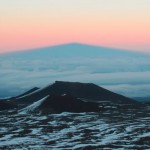The sunset view from the summit of Mauna Kea is truly spectacular. From the summit you are usually above the clouds, watching the sun sink into a cloud layer thousands of feet below. The colors are intense, the deep blue sky, the red cinder and the gleaming telescope domes. This spectacle draws tourists from across the globe, trekking up the mountain just in time to witness sunset.

Oddly enough, it seems that the actual shape of the mountain is not that important in the creation of such a triangular shadow. The shadow will show that beautiful shape regardless of the mountain’s profile. Even a flat topped mountain will have a shadow that converges to a point at the top. This contradicts our experience, where common shadows match the shape of the casting object. We expect a shadow to portray the object.
A mountain shadow is different, the shadow is elongated to a great distance by the scales involved, in this situation the geometry dictates a different result. The secret to the shape of the shadow is that it is driven by the effects of perspective, with the shadow reaching to a vanishing point in the far distance. In 1979 the problem of the mountain shadow shape was mathematically modeled by William Livingston and David Lynch. They showed that regardless of the mountain’s profile a conical shadow would be perceived by a viewer near the summit. The proportions may differ depending on the profile of the mountain, but the conical shape would remain.
In the case of Mauna Kea, the effect is not obvious, the mountain does have a fairly symmetrical shape with steep sides. A viewer might not recognize the fact that the projected shadow does not match the shape of the volcano. An astute observer may notice a discrepancy, Mauna Kea is notably rounded at the summit, yet the shadow possesses a sharp apex.
I was completely unaware of this until it was pointed out to me a few days ago by Dean Ketelsen when I posted the Mauna Kea mountain shadow image. I suspect Dean has had many opportunities to see this phenomena from atop Kitt Peak, a flat topped mountain that casts a conical shadow.
